
A time zone is an area that observes a uniform standard time for legal, commercial and social purposes. Time zones tend to follow the boundaries between countries and their subdivisions instead of strictly following longitude, because it is convenient for areas in frequent communication to keep the same time.
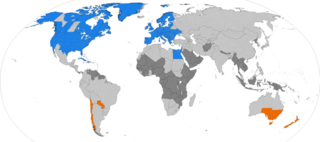
Daylight saving time (DST), also known as daylight savings time or daylight time, and summer time, is the practice of advancing clocks during warmer months so that darkness falls at a later clock time. The typical implementation of DST is to set clocks forward by one hour in the spring and set clocks back by one hour in autumn to return to standard time. As a result, there is one 23-hour day in late winter or early spring and one 25-hour day in the autumn.
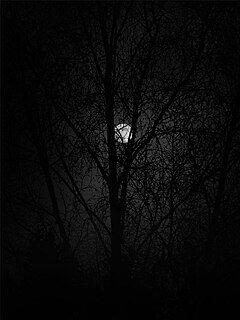
Midnight is the transition time from one day to the next – the moment when the date changes, on the local official clock time for any particular jurisdiction. By clock time, midnight is the opposite of noon, differing from it by 12 hours.
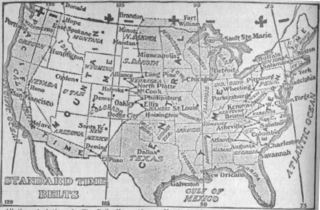
The history of standard time in the United States began November 18, 1883, when United States and Canadian railroads instituted standard time in time zones. Before then, time of day was a local matter, and most cities and towns used some form of local solar time, maintained by some well-known clock. The new standard time system was not immediately embraced by all.

The Eastern Time Zone (ET) is a time zone encompassing part or all of 23 states in the eastern part of the United States, parts of eastern Canada, the state of Quintana Roo in Mexico, Panama and Colombia, mainland Ecuador, Peru, and a small portion of westernmost Brazil in South America, along with certain Caribbean and Atlantic islands.

The Alaska Time Zone observes standard time by subtracting nine hours from Coordinated Universal Time (UTC−09:00). During daylight saving time its time offset is eight hours (UTC−08:00). The clock time in this zone is based on mean solar time at the 135th meridian west of the Greenwich Observatory.

Time in the United States, by law, is divided into nine standard time zones covering the states, territories and other US possessions, with most of the United States observing daylight saving time (DST) for approximately the spring, summer, and fall months. The time zone boundaries and DST observance are regulated by the Department of Transportation. Official and highly precise timekeeping services (clocks) are provided by two federal agencies: the National Institute of Standards and Technology (NIST) ; and the United States Naval Observatory (USNO). The clocks run by these services are kept synchronized with each other as well as with those of other international timekeeping organizations.
Time in New Zealand is divided by law into two standard time zones. The main islands use New Zealand Standard Time (NZST), 12 hours in advance of Coordinated Universal Time (UTC) / military M (Mike), while the outlying Chatham Islands use Chatham Standard Time (CHAST), 12 hours 45 minutes in advance of UTC / military M^ (Mike-Three).

The Atlantic Time Zone is a geographical region that keeps standard time—called Atlantic Standard Time (AST)—by subtracting four hours from Coordinated Universal Time (UTC), resulting in UTC−04:00. During part of the year, some portions of the zone observe daylight saving time, referred to as Atlantic Daylight Time (ADT), by moving their clocks forward one hour to result in UTC−03:00. The clock time in this zone is based on the mean solar time of the 60th meridian west of the Greenwich Observatory.

South African Standard Time (SAST) is the time zone used by all of South Africa as well as Eswatini and Lesotho. The zone is two hours ahead of UTC (UTC+02:00) and is the same as Central Africa Time. Daylight saving time is not observed in either time zone. Solar noon in this time zone occurs at 30° E in SAST, effectively making Pietermaritzburg at the correct solar noon point, with Johannesburg and Pretoria slightly west at 28° E and Durban slightly east at 31° E. Thus, most of South Africa's population experience true solar noon at approximately 12:00 daily.

The U.S. state of Indiana is divided between Eastern and Central time zones. The official dividing line has generally moved progressively west from its original location on the Indiana–Ohio border, to a position dividing Indiana down the middle, and finally to its current location along much of the Indiana–Illinois border. In April 2006, several southwestern and northwestern counties reverted to Central time, although by late 2007 all but two had returned to Eastern time.
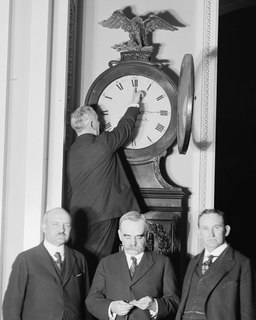
Daylight saving time in the United States is the practice of setting the clock forward by one hour when there is longer daylight during the day, so that evenings have more daylight and mornings have less. Most areas of the United States and Canada observe daylight saving time (DST), the exceptions being Arizona, Hawaii, and the overseas territories of American Samoa, Guam, the Northern Mariana Islands, Puerto Rico, and the United States Virgin Islands. The Uniform Time Act of 1966 established the system of uniform daylight saving time throughout the US.
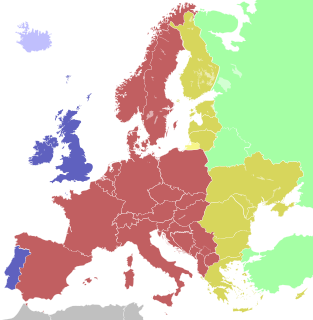
Europe spans seven primary time zones, excluding summer time offsets. Most European countries use summer time and harmonise their summer time adjustments; see Summer time in Europe for details.
Time in Arizona, as in all U.S. states, is regulated by the United States Department of Transportation as well as by state and tribal law.

Time in Maine, as in all US states, is regulated by the United States Department of Transportation. All of Maine is in the Eastern Time Zone (ET) and observes daylight saving time (DST).

Time in Massachusetts, as in all US states, is regulated by the United States Department of Transportation. Massachusetts is in the Eastern Time Zone (ET) and observes daylight saving time (DST).

Time in New Hampshire, as in all US states, is regulated by the United States Department of Transportation. New Hampshire is in the Eastern Time Zone (ET) and observes daylight saving time (DST).

Time in Rhode Island, as in all US states, is regulated by the United States Department of Transportation. Rhode Island is in the Eastern Time Zone (ET) and observes daylight saving time (DST).

Time in Connecticut, as in all US states, is regulated by the United States Department of Transportation. Connecticut is in the Eastern Time Zone (ET) and observes daylight saving time (DST).
Permanent standard time refers to the year-round observation of standard time. Likewise, permanent daylight saving time refers to the year-round observation of daylight saving time (DST). Both permanent standard time and permanent DST eliminate the practice of biannual clock changes, specifically the advancement of clocks by one hour from standard time to DST in spring and the retraction of clocks by one hour from DST to standard time in fall. In the United States, Arizona, Hawaii, and all territories observe permanent standard time. Observation of permanent DST is forbidden by the Uniform Time Act.











